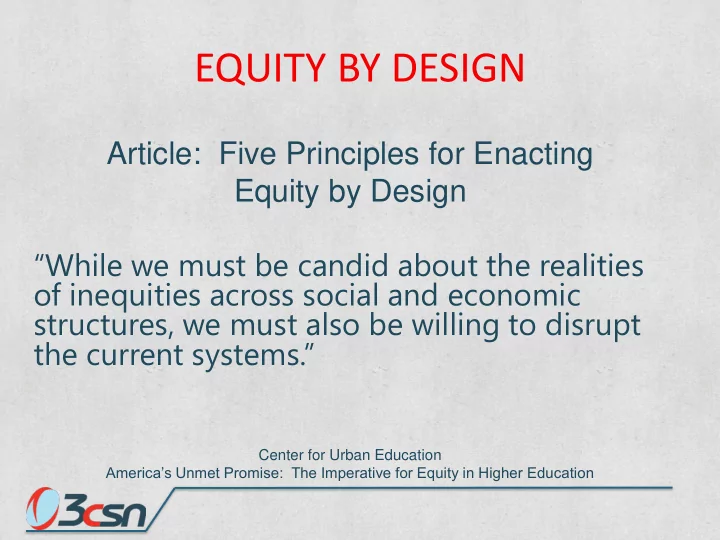

EQUITY BY DESIGN Article: Five Principles for Enacting Equity by Design “While we must be candid about the realities of inequities across social and economic structures, we must also be willing to disrupt the current systems.” Center for Urban Education America’s Unmet Promise: The Imperative for Equity in Higher Education
“Yet in spite of the well - meaning rhetoric of “student success,” national and institutional data illustrate that many institutions continue to fall short in producing positive outcomes for a significant proportion of college students. And, at many HSIs, Latino/a students — the very students that these institutions purport to serve — experience inequities in educational outcomes including persistence, degree completion, and participation in high- demand fields.” (Contreras, Malcom, & Bensimon, 2008; Malcom- Piqueux, Suro, Bensimon, & Fischer, 2013)
Principle 1 Clarity in Language, goals, and measures is vital to effective equitable practices . • Inequality in higher ed is structural - language imbued with political and social meaning. (deficit labels and language) • Simplify data reports • Use data more purposefully to assess success patterns by race, ethnicity, and course sections (offer more intentional coaching for faculty with large equity gaps in their outcomes).
Principle 2 Equity-Mindedness should be the guiding paradigm for language and action. • An equity ‐ minded approach raises consciousness of the need to consider equity in connection with historical and political understandings of stratification. • Awareness of exclusionary practices and racism in higher ed, impact of power asymmetries on opportunities and outcomes, particularly for African Americans and Latinas/os.
Principle 2 Equity-minded individuals are … • Color-conscious in a critical sense • Aware that beliefs, expectations, and practices assumed to be neutral can have outcomes that are racially disadvantageous. • Willing to assume responsibility for the elimination of inequality. • Aware that while racism is not always overt, racialized patterns permeate policies and practices in educational institutions (disproportionate impact)
Principle 3 Equitable practice and policies are designed to accommodate differences in the contexts of student’s learning — not to treat all students the same. “Achieving equality in outcomes does not mean treating all students as though they are the same. Equity ‐ focused policies and practices should recognize and accommodate differences in students’ aspirations, life circumstances, ways of engaging in learning and participation in college, and identities as learners and students.” ( America’s Unmet Promise )
Principle 4 Enacting equity requires a continual process of learning, disaggregating data, and questioning assumptions about relevance and effectiveness. • What matters is how we interpret the data. Do we interpret racialized inequities as a symptom of student deficiencies or an indication of failed practices? • Through inquiry question routines and practices to learn what works and why some things may not be working as intended. • “Change cannot be secured if participants do not change themselves, their understandings, their practices, or their constitutional settings.” ( Kemmis and McTaggart , 2000, 590).
Principle 5 Equity must be enacted as a pervasive institution and system-wide principle. • Institutions should approach equity as a normative standard for all aspects of the institution, from resource allocation to assessment to strategic planning. • Embedding equity into the core of institutional work means reframing inequity as a problem created by color ‐ blind practices and procedures and the lack of spaces to talk about race.
Principle 5 Embedding equity requires … • Asking questions differently. – From - What does this student lack and how can he/she be remediated? – To - Why are our practices failing to produce success for students from marginalized communities? • Learn to make the pursuit of equity a normal practice • Consider how problems and solutions are defined, implemented, and evaluated. • Faculty, administrators, and staff, must demonstrate equity ‐ mindedness through language, reasoning, and action.
Logic Model & Braiding Equity Think about … • How is equity embedded or “baked” into your logic model’s outcomes, activities? • Think, Pair, Share • Chart Whole Group Debrief
Marrying Your Goals With an Equity Lens-Gallery Walk Activity with Your Simplexity Visual Representation You will be providing feedback on the simplexity posters. Using post-its, answer the following questions per poster 1. How would the team bring equity mindedness into their vision for success? 2. What questions/inquiry should the team ask of the campus (think about stakeholders, data, programs, faculty) 3. What content should be included to demonstrate competency/humility?
ULTIMATE GOAL – Equity by Design Equity principles, culturally responsive teaching and learning pedagogy, and other high-impact practices are embedded throughout • policies, procedures, strategic planning initiatives • course design, instruction (f2f and online) • delivery of services • campus culture • all aspects of the institution
Recommend
More recommend